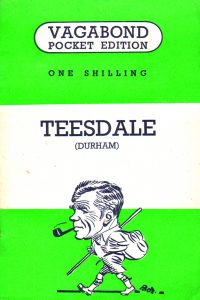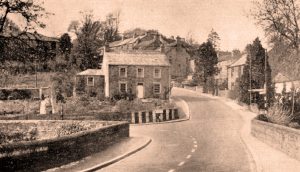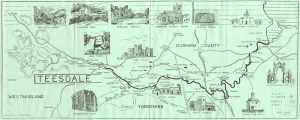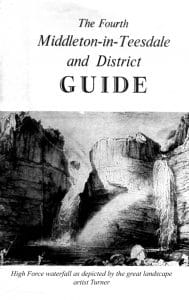Guides from past times
Guide books for visitors to Upper Teesdale are few and far between but we discovered three guides from the past which give a feel for the enjoyment have always gained from visiting the area.
-
- Illustrated Guide to Middleton-in-Teesdale and District By John C. Raine Publisher M. Richardson, 5 & 6 Horsemarket Printed by Teesdale Mercury (date unknown)
- Vagabond (pocket edition) Teesdale (Durham) Dale Series North East Publications, Gateshead 1947
- Walkabout Illustrated leaflet published by Durham County Council, 1995
‘City mentality is compressed into a desire for speedy travel, artificial entertainment, and other things estranged from the delights of the countryside. It creates a mind apart from the true spirit of England ; here, in Teesdale, strolling along the river banks, crossing the meadows, gazing into the cottage gardens, heart and mind completely in tune with eternal things, there is joy, rich beyond measure.’ – The Vagabond

Shut your eyes and imagine coming to Upper Teesdale about 80 years ago. Judging by earlier guide books, very little has changed. Shops and pubs have gone and come, there’s more traffic, but in essence the attractions remain the same – the magnificent scenery surrounding the mighty River Tees and its settlements, with their rich history.
These three publications offer different and fascinating glimpses through their descriptions and local advertisements. There is the careful, lyrical prose of John Raine, steeped in local knowledge; the vivid and often swashbuckling descriptions by ‘The Vagabond’ and a thoughtful summary with fascinating details in the 1995 ‘Walkabout’ leaflet. A visit to Teesdale was considered to do you good (and still does, of course!). John Raine summarises: ‘Teesdale… has for its attractions a wealth of riverside scenery, bracing stretches of moorland (clothed in Summer with beautiful purple heather), sweet scented pinewoods, and a sub-Alpine flora almost unique in England. The air is pure, mild and bracing, it carries with it the tang of the mountain and the scents of the surrounding moorland; and when it is disturbed it is by a south-westerly cooling breeze, laden with ozone, the elixir of health.’
Raine quotes a poem by A. Fox, 1881, which summarises the pride of the dale:
River of beauty, peerless,
Whether in storm or calm,
A nameless spell is round thee!
A wondrous power to charm,
Germans may praise their castled Rhine,
Tiber was loved of Rome,
But our fair Tees surpasses these
‘Tis the River of our home.

And it was not only the scenery that has attracted visitors. The Cleveland Arms (now the Teesdale Hotel), the oldest inn still in the village, in 1916 was reputed to offer “To those who have been unnerved by Air Raids… a safe retreat out of all danger, where a rest amid the beauties of Teesdale will gradually build up the body”.
Twenty odd years later, the High Force Hotel was advertising itself as providing Electric Light and Every Modern Convenience’. The Heatherbrae Hotel at Snaisgill (now a private home) similarly boasts ‘Every Modern Comfort including Central Heating and Electric Light’. The Teesdale Queen offered regular buses in the dale and the OK Motor Services provided coaches, urging customers with “The roads are YOURS – use them!’.
The Vagabond’s booklet was one of a series published ‘in the interests of the cultural, social and industrial welfare of the North Country’. His ambition is evident in the illustrated cover where he strides out in shorts, pipe firmly clenched, with his rucksack and staff. Moreover:
‘The Vagabond is prepared to come and tell these stories in any city, town, holiday centre or rural district desirous of being included in the pocket editions; terms by arrangement. Constructive criticism and suggestions for further books are welcomed from readers.
He equals Raine’s evident appreciation of the dale, though in more robust terms:
The high, wild, and undulating roads into it from Stanhope in the North, and Brough in the South-West, make an oasis of Middleton-in-Teesdale. The windswept uplands around it make it shine like a meadow in the midst of a desert’. Its townsfolk ‘are prepared to feed and wash and rest the dust-stained traveller. About Middleton-in-Teesdale there is no architectural charm; no castles or towers. But it is an extremely homely, comfortable place in which to stay for a while, to make closer contact with the mellow glory of Teesdale.
Despite the decline of the lead and ore mining industry, the Vagabond says that the village ‘assuredly remains a nucleus of typical Teesdale agricultural folk, with an appropriate sprinkling of craftsmen and tradesmen to keep the town in trim, and to uphold its traditions. ‘And who can say that the “sights” of Teesdale are of less importance than the warmth and comfort of the accommodation available?’

At the time Raine was writing, quarrying and farming were the chief industries. Messrs. Ord & Maddison’s had extensive quarries and works behind the railway station and further up dale (the latter is still operating) and a ‘large Tar Macadam mixing plant built upon the site of the Co-operative Coal Depot, also near the Station’. He also notes that ‘…a local man, Mr. R. W. Raine, attempted to revive the industry at Coldberry, but upon his death, even those efforts were discontinued. Lately new efforts are being made and great activities can be seen around the mines. It is promised that they will be in full production soon.’ There is no mining now in the area.
But it is the Tees and the course it has carved through the dale that has always drawn visitors. The Vagabond asserts that the river was named ‘Tees’ by the Celts, meaning ‘fertiliser’. ‘In Roman, Saxon, Norman and successive eras, Teesdale had been loved and honoured for its verdant charm. It is the aristocrat of English water-ways weaned in the bosom of The Pennine Range at Cross Fell. There it plays among ageless rocks, as it has done for millions of years before the Dawn of Humankind; it is familiar with World History.’
He writes of ’a wild track running over The Pennines, through High Cup Nick’, (presumably the forerunner of the Pennine Way) and notes seeing ‘sea-shore shells embedded in the sandstone…. it was once under the sea.’ Recognising the importance of geological history, the Vagabond goes on to a stirring summary of how the dale was formed:
With but a primary introduction to the “record of the rocks,” this wilderness of Upper Teesdale becomes a comprehensive attestation of Creation, Evolution and the advent of human life. These rocks belong to the age before plant-life or trees ; older by far than the Durham County coal-seams where tropical forests were crushed into coal…see the fossils of leaves, tree-bark and dragon-flies. Repeatedly smothered in mighty glaciers, hurled aside by volcanic eruption, then submerged in cooling seas, these rocks were the resting places of reptiles and fish, and the Tees was born 50,000,000 years ago, round about the time of which even scientists have wavering knowledge. I wandered over to an old lead-mine, slate quarries and strata of shale; all products of the Lower Carboniferous Period, and only my imagination could conjure up the fact of them once being a flaming red mass. At another time, at this altitude, it would be a thousand feet below the surface of the sea. The whole subject is out of the depths of ordinary folk; it is an intellectual frustration, yet brings realisation of the immensity of Creation; the evidences are all there. That is Teesdale in the raw.
One thing has changed though since the early 20th century guides: the loss of the long winding stretch of the Tees before it crashes down over Cauldron Snout. This lazily twisting river on a plateau was an outstanding habitat for rare flora, now lost forever with the creation of Cow Green reservoir in 1971. John Raine says ‘The Weel of the Tees, bordered as it is by wild moorland, is very impressive. It is almost two miles long and almost motionless. It acts as a reservoir to the roaring cataract below.’
He records that the Weel at Cauldron Snout inspired a famous painter to create the picture entitled The Plains of Heaven which is held by the Tate Gallery.
Above the fall the Tees makes a sharp turn, and here it is seen rushing over the huge basaltic rocks, and by the time it reaches the fall itself the water is white with froth. The cataract is almost 500 yards long; with a fall of 200 feet. It is the highest fall in England. It is seen at its best on a moonlight night after heavy rains.
The Vagabond, more dramatically, says the river ‘sulks at The Weel. There, it gathers force, then, suddenly, with little warning, hurls itself into Cauldron Snout gorges, roars in rage and frustration, and wins its way into a longer, deeper gorge, and becomes even more defiant.’
‘Talk not of foreign cascade or far waterfall,
For the glory of Cauldron outrivals them all,
From rock to rock, bounding and foaming with pride,
In eddies and whirlpools its swift waters glide,
Above the fierce torrent and high in the air,
A wooden bridge dangles—the verge of despair.’
From Fletcher’s Nooks and Corners of Yorks, quoted in Raine.
Downriver, the Winch Bridge by Bowlees, and Holwick strike a poetic chord with John Raine:
Here is a scene of extreme beauty— dark grey, riven rocks form the bed of the river, dividing the boiling fall into a miniature High Force. There are also deep basins of brown coloured water as peaceful as its neighbour is troubled. The bridge itself was erected in 1830 to replace an earlier structure believed to have been the first suspension bridge in Europe… Towards the end of August, 1820, a party of nine people were passing over the bridge from the Holwick to the Durham side, and the severe strain placed upon the bridge caused one of the chains to snap. Three people were thrown into the river, and one was dashed to pieces on the rocks. The others, falling into the water, were rescued.
From a little further downriver, towards the Scorberry Bridge, Raine writes ‘There is romance in journeying to Holwick over the remaining fields. The path, swinging left, then right, seems to have taken the lines of hares, or sheep; or courting couples, who wilt not the way they went, but only kept on walking until the stiles are reached.
He quotes local poet Richard Watson (born in Middleton in 1833) about a beauty spot above Holwick:
My youthful days near Nancy
Seem like a pleasant dream,
When arm in arm we rambled
By the rippling silver stream,
We gathered nuts and sloes, love,
And wild flowers you loved well,
By shady bower and rock, love,
Up in the Fairy Dell.
 Raine relates a story about the growth of Methodism and the founding of the chapel at Bowlees in 1845, which now houses the visitor centre:
Raine relates a story about the growth of Methodism and the founding of the chapel at Bowlees in 1845, which now houses the visitor centre:
‘The incident is recorded of Willie Wilkinson’s interview with the Duke of Cleveland concerning the site for a Chapel. The Duke and a distinguished shooting party were staying at the High Force Hotel, and Willie, it is said, accompanied by a travelling preacher, made his way hither. On asking permission to see his Grace, he was, of course, refused, but breaking past the man in buttons, Willie, closely followed by his companion, halted not until he reached the ducal presence. Without hesitation he walked up to his Grace, and grasping him by the hand, exclaimed: “How are ye Mister Duke, and hoo’s Misses Duke? And hoo’s little Dukes? The Duke instantly saw that he had a “character” before him, and adopting himself with adroitness to the situation, asked Willie what he wished. Willie said he wanted a bit of “grund” on which to build a chapel, and, replied the Duke, “You shall have a piece of land, most certainly, my good man.” “Mister Duke, if we get some o’t poachers converted in’t chapel we want to build, yell mebbe be obleeged to us.”
Next morning at 9 o’clock to the minute, Willie triumphantly staked out the allotted land in the presence of the agent. Thus was another bit of Methodism forwarded in the dale.’
Elswhere we have a guide to the King’s Walk and Aukside. We also posted a blog piece about the King’s Walk in 1920 see it here. Raine gives his version of a walk which also takes in Jack Scar Cave:
KING’S WALK, JACK SCAR AND THE HORSE SHOE FALLS. (Distance: 2 miles.)
Take the road up Town Head and enter the woods through the second opening on the left. Proceed about 60 yards, and leaving the road pass through the gate on the right. You now enter upon what is known as The King’s Walk, a delightful walk through the woods. Continue along until you come to Snaisgill Beck, cross the wooden bridge, and follow the path until it eventually brings you out on to the Skeers Road. Turn right and proceed along the road, cross over the, stone bridge, and follow Skeers Beck until Jack Scar is reached. At the entrance to the gorge will be seen an old Level of the London Lead Company, and close by the earthworks of a former cottage. Proceed through the Scar.
High up on the limestone across the beck will be seen the narrow entrance to the Cave of Jack Scar. To continue further through the Scar it is necessary to descend amongst the rocks and boulders of the beck, and cross over to the other side. The Gorge then opens considerably, revealing fresh country to explore. Returning, keep to the road, and around the corner from where the wood path emerges will be seen the lovely Horse Shoe Falls. Continue along until the road divides, and then bear right – over the rustic wooden bridge – past the Scout House, and out again at the head of Hude (near Middleton House). Descend Hude and re-enter the town over Hudeshope Beck.
An alternative road offers near the wooden bridge on the return journey, this comes out at Town Head, where the woods were entered. At a point where the paths diverge, there may be found in season one of Teesdale’s rarest of wild flowers, “The Major Strata.” It flowers in late June, and seeks protection in its colour, which is green. Another road branches off at the Scout Hut, and after crossing the Hudeshope Beck and continuing a little way alongside the Holme Gardens (formerly a washing floor of the, London Lead Company) itself divides. One path re-crossing the beck over a plank bridge, and climbing out to the head of Hude. The other coming out to the middle of Town Head
John C. Raine’s Illustrated Guide to Middleton-in-Teesdale and District, page 7.



